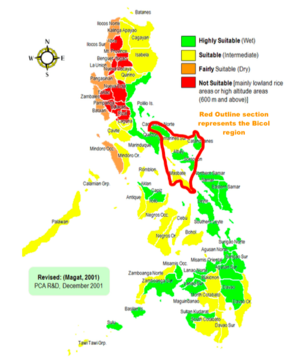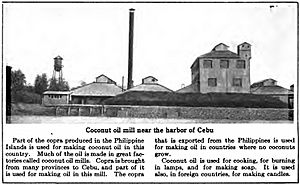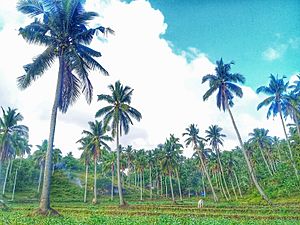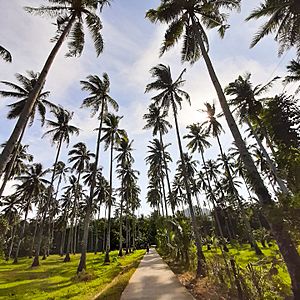Coconut production in the Philippines facts for kids
Coconuts are a really big deal in the Philippines! Growing and selling coconuts helps the country's economy a lot. The Philippines is one of the world's top producers of coconuts. In 2009, they grew an amazing 19,500,000 tonnes of coconuts. Most of these coconuts come from medium-sized farms.
The Philippines is also the world's leading producer and seller of virgin coconut oil. This special oil is made from fresh coconuts.
Contents
How Coconut Farming Grew


Coconut farming in the Philippines has grown a lot over the years. Between 1911 and 1929, coconut production increased by about 5.3% each year. It grew by another 3.5% from 1966 to 1970.
In 2012, the Philippines sent out more than 1.5 million tonnes of coconut products to other countries. These products included copra (dried coconut meat), coconut oil, and even charcoal made from coconut shells. This was a small increase from the year before.
By 1989, the Philippines was the second largest coconut producer, growing 11.8 million tonnes. They later grew even more than Indonesia. In 1989, coconut products like coconut oil and copra made up about 6.7% of all things the Philippines sold to other countries.
Where Coconuts Grow
In the early 1990s, about a quarter of all farmed land in the Philippines was used for coconut trees. It's thought that between 25% and 33% of the people in the Philippines depended on coconuts for their living.
Historically, the southern parts of Luzon (like Southern Tagalog and Bicol) and the Eastern Visayas were the main places for growing coconuts. Later, Western Mindanao and Southern Mindanao also became important coconut-growing areas.
Coconut Farms and Farmers
Most coconut farms in the early 1990s were medium-sized, usually less than four hectares (about 10 acres). Often, the farm owners didn't live on the farm. Instead, they hired local villagers to pick the coconuts. These workers were paid for each coconut they collected. People who worked in the coconut industry often had less schooling and earned less money than other rural workers.
Today, about 3.6 million hectares of land in the Philippines are used for growing coconuts. This is about a quarter of all the country's farmland. The amount of land used for coconuts grew quickly in the 1960s and 1970s. This happened because the value of the Philippine peso (PHP) went down, and more countries wanted coconut products.
The Philippine government encouraged making more coconut oil in the country. They helped build more coconut oil mills. The number of mills grew from 28 in 1968 to 62 in 1979.
Helping the Coconut Industry
In 1973, the government created a special agency called the Philippine Coconut Authority (PCA). This agency was in charge of all government activities related to coconuts. The PCA could collect a small fee on every 100 kilograms of copra sold. This money was meant to help keep the price of coconut products, like cooking oil, stable for people in the Philippines.
In 1974, the government also started the Coconut Industry Development Fund (CIDF). This fund was created to help develop a new type of hybrid coconut tree. To pay for this project, the fee collected on copra was increased.
The PCA also bought a bank, which was renamed the United Coconut Planters Bank. This bank was meant to help coconut farmers. The fees collected by the PCA were put into this bank.
Later, in 1978, the United Coconut Planters Bank was allowed to buy coconut mills. This was supposed to help with too many mills in the industry. By the early 1980s, one company, United Coconut Oil Mills (which was linked to the PCA), controlled most of the coconut oil production in the Philippines.
Challenges and Changes
The money collected from the coconut fees was supposed to help the farmers. They were promised benefits like life insurance and scholarships. However, not many farmers actually received these benefits.
There was also a plan to replace old coconut trees with a new hybrid type. These new trees were supposed to produce much more coconut per year. But the goal of planting 60,000 new trees each year was not met. By 1983, about 25% to 30% of coconut trees were very old (at least 60 years old). By 1988, this number grew to between 35% and 40%.
When coconut prices started to drop in the early 1980s, there was pressure to change how the industry worked. In 1985, the Philippine government agreed to break up the United Coconut Oil Mills.
Later, in 1988, a law in the United States required foods with tropical oils to say how much saturated fat they had. This negatively affected the coconut industry, which was already struggling. Coconut growers protested, saying that similar rules were not applied to oils from other climates.
Despite these challenges, by 1995, coconut production in the Philippines had grown by 6.5% each year. The Philippines eventually became the world's top producer of coconuts, surpassing Indonesia.
Images for kids
-
Coconut palm trees on the beach of Sabang, Palawan




